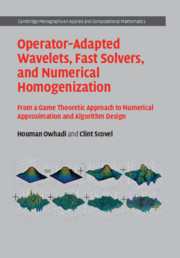 Operator-Adapted Wavelets, Fast Solvers, and Numerical Homogenization
Operator-Adapted Wavelets, Fast Solvers, and Numerical Homogenization Book contents
- Frontmatter
- Dedication
- Contents
- Preface
- Acknowledgements
- Reading Guide
- 1 Introduction
- Part I The Sobolev Space Setting
- 2 Sobolev Space Basics
- 3 Optimal Recovery Splines
- 4 Numerical Homogenization
- 5 Operator-Adapted Wavelets
- 6 Fast Solvers
- Part II The Game Theoretic Approach
- Part III The Banach Space Setting
- Part IV Game Theoretic Approach on Banach Spaces
- Part V Applications, Developments, and Open Problems
- Part VI Appendix
- Bibliography
- Algorithms
- Glossary
- Nomenclature
- Index
- Identities
2 - Sobolev Space Basics
from Part I - The Sobolev Space Setting
Published online by Cambridge University Press: 10 October 2019
- Frontmatter
- Dedication
- Contents
- Preface
- Acknowledgements
- Reading Guide
- 1 Introduction
- Part I The Sobolev Space Setting
- 2 Sobolev Space Basics
- 3 Optimal Recovery Splines
- 4 Numerical Homogenization
- 5 Operator-Adapted Wavelets
- 6 Fast Solvers
- Part II The Game Theoretic Approach
- Part III The Banach Space Setting
- Part IV Game Theoretic Approach on Banach Spaces
- Part V Applications, Developments, and Open Problems
- Part VI Appendix
- Bibliography
- Algorithms
- Glossary
- Nomenclature
- Index
- Identities
Summary
This chapter introduces the Sobolev spaces and self-adjointellipticoperators on those spaces that will be used through the book. It also introduces basic concepts and tools such as Gelfand triples, the Sobolev embedding theorem, the equivalence between energy norm and the Sobolev space norm, the dual norm, the Green's function, and eigenfunctions.
Keywords
- Type
- Chapter
- Information
- Operator-Adapted Wavelets, Fast Solvers, and Numerical HomogenizationFrom a Game Theoretic Approach to Numerical Approximation and Algorithm Design, pp. 25 - 33Publisher: Cambridge University PressPrint publication year: 2019
